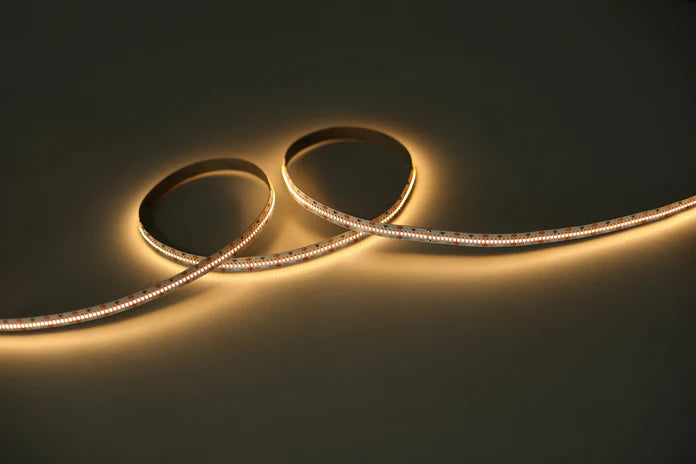
How to identify & control the quality of LED strip?Part.2
Nine procedures for quality identification
1. LED quality and maintenance: LM-80 reliability
Yuji Lighting QC procedure identifies the LED reliability according to the LM-80 report or calculated from the TM-21. Figure 5 is an LM-80 data example of Yuji Lighting LEDs at Ts 55°C. Since the features of the different LEDs are always different, thus the QC standard depends on the specific case or customer requirements.


Figure 5: An LM-80 data report of Yuji Lighting LEDs at Ts 55°C and RH<65%
2. Adhesive force test: instant




1. Adhesive tape on a steel plate.
2. Compact the adhesive tape.
3. Untape the double-faced adhesive tape.
4. Cover and compact the other steel plate.
After making the test example described above, we will use the tape holder tack tester (Figure 6) for a 4-hour and 1kg weight test to evaluate the adhesive force of the tape.After 4 hours the steel plate should never separate or tend to separate.

Figure 6: Tape holder tack tester.
3. Adhesive force test: maintenance
The instant test of adhesive force is not enough and we will do more practical tests to simulate the real environment of use. At least we will choose lime wall, anodized aluminum, wood and metal which are the most frequently used for the adhesive tape maintenance test. With full-power driving, the LED strip should not separate or tend to separate after 72 hours of continuous work, and will also keep the primary strip for long-term verification up to 2 years (Figure 7).


Figure 7: Long-term verification of adhesive force on different materials.
4. Physical stress force: substrate tension
Both of the strip substrate tension (>30kgf) and soldering point tension (>10kgf) will be identified and tested (Figure 8). The tested LED strip should be 100% no-separation or never tend to be separated.

Figure 8 Substrate tension test.
5. Physical stress force: rolling tension & SMT fastness
The rolling tension test (Figure 9) is to simulate the possible scenarios of rolling or unrolling the strips during the cut, mounting and packaging.
• Rolling diameter: 50mm;
• Rolling speed: 200mm/s;
• Rolling cycle: 1000 loops.
100% of the tested LED strip should be intact and 100% of the components on the strip should be solid without separation or tending to be separated


Figure 9: Rolling tension test.
6. Physical stress force: swing tolerance & SMT fastness
The swing stress test (Figure 10) is to simulate the possible man-made situation to swing the LED strip then the components on the strip will vibrate accordingly. After 1000 loops of swing with 100/min speed, 100% of the tested LED strip should be intact and 100% of the components on the strip should be solid without separation or tending to be separated.


Figure 10: Swing tolerance test.
7. Physical stress force: torsional stress & SMT fastness
The torsional stress test (Figure ) is from another coordinate axis to evaluate the quality. Based on a 1-meter length, the LED strip edge will be torsional for two laps (720°) with a speed of 720° per second. After 1000 loops, 100% of the tested LED strip should be intact and 100% of the components on the strip should be solid without separation or tending to be separated.


Figure 11: Torsional stress test.
For all of the physical stress force tests, we will do both the cold state (LED off) and thermal state (LED on) to cover all possibilities of the actual use scenarios.
8. Temperature force: thermal shock
In the thermal shock test (Figure 12), the LED strip will be unrolled in the thermal shock test chamber with the following conditions:
• Thermal shock range: -40°C ~ +85°C;
• -40°C and +85°C will be kept for 15 minutes;
• The thermal shock cycle is per 0.5-hour and 50 cycles in total.
After all of the tests and after it turns to the standard ambient temperature , the LED strip will be observed that they should be normal for the adhesive and appearance, then the LED strip will be tested and compared to their initial status, all of the photoelectric test data should be the same without any fluctuation.

Figure 12: Thermal shock test.
9. Temperature force: accelerated aging
The accelerated aging test (Figure 13) aims to simulate a very extreme environment and it is also generally called the dual-85 test with the following conditions:
• Ambient temperature 85°C and ambient humidity 85%;
• The LED strip is working during the test;
• The test lasts 48 hours.
After all of the tests and after it turns to the standard ambient temperature , the LED strip will be observed that they should be normal for the adhesive and appearance, then the LED strip will be tested and compared to their initial status, all of the photoelectric test data should be the same without any fluctuation.

Figure 13: Accelerated aging test.
Last - but not least
With all of these test theories and actual procedures, the quality of the LED strip is evaluated and verified but it is not the end of securing the quality, the LED strip manufacturer should commit to repeat such tests when any of the materials or components changes to re-evaluate the quality. Nevertheless, users should also take care of the human factor during the operations of unboxing, cutting, and mounting the LED strip because in many cases the LED strip is damaged in this way. Hopefully we all can enjoy the wonderful lighting from the LED strip without any worries.

Leave a comment